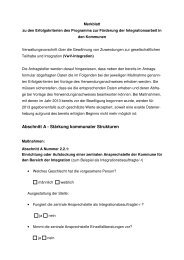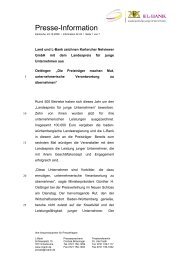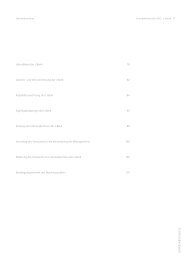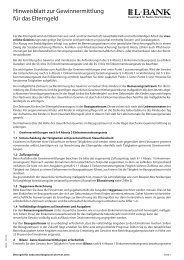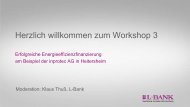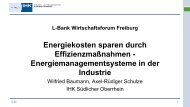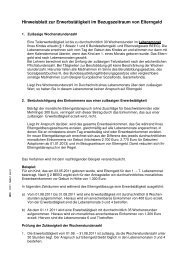Landeskreditbank Baden-Württemberg - L-Bank
Landeskreditbank Baden-Württemberg - L-Bank
Landeskreditbank Baden-Württemberg - L-Bank
Create successful ePaper yourself
Turn your PDF publications into a flip-book with our unique Google optimized e-Paper software.
accrual period is increased (or decreased) if the interest actually paid during an accrual period exceeds (or is less<br />
than) the interest assumed to be paid during the accrual period pursuant to the foregoing rules.<br />
In general, any other Variable Debt Security that qualifies as a variable rate debt instrument will be<br />
converted into an equivalent fixed rate debt instrument for purposes of determining the amount and accrual of<br />
original issue discount and qualified stated interest on the Variable Debt Security. The OID Regulations<br />
generally require that such a Variable Debt Security be converted into an equivalent fixed rate debt instrument by<br />
substituting any qualified floating rate or qualified inverse floating rate provided for under the terms of the<br />
Variable Debt Security with a fixed rate equal to the value of the qualified floating rate or qualified inverse<br />
floating rate, as the case may be, as of the Variable Debt Security’s issue date. Any objective rate (other than a<br />
qualified inverse floating rate) provided for under the terms of the Variable Debt Security is converted into a<br />
fixed rate that reflects the yield that is reasonably expected for the Variable Debt Security. In the case of a<br />
Variable Debt Security that qualifies as a variable rate debt instrument and provides for stated interest at a fixed<br />
rate in addition to either one or more qualified floating rates or a qualified inverse floating rate, the fixed rate is<br />
initially converted into a qualified floating rate (or a qualified inverse floating rate, if the Variable Debt Security<br />
provides for a qualified inverse floating rate). Under such circumstances, the qualified floating rate or qualified<br />
inverse floating rate that replaces the fixed rate must be such that the fair market value of the Variable Debt<br />
Security as of the Variable Debt Security’s issue date is approximately the same as the fair market value of an<br />
otherwise identical debt instrument that provides for either the qualified floating rate or qualified inverse floating<br />
rate rather than the fixed rate. Subsequent to converting the fixed rate into either a qualified floating rate or a<br />
qualified inverse floating rate, the Variable Debt Security is then converted into an equivalent fixed rate debt<br />
instrument in the manner described above.<br />
Once the Variable Debt Security is converted into an equivalent fixed rate debt instrument pursuant to the<br />
foregoing rules, the amount of original issue discount and qualified stated interest, if any, are determined for the<br />
equivalent fixed rate debt instrument by applying the general original issue discount rules to the equivalent fixed<br />
rate debt instrument and a U.S. Holder of the Variable Debt Security will account for such original issue discount<br />
and qualified stated interest as if the U.S. Holder held the equivalent fixed rate debt instrument. In each accrual<br />
period appropriate adjustments will be made to the amount of qualified stated interest or original issue discount<br />
assumed to have been accrued or paid with respect to the equivalent fixed rate debt instrument in the event that<br />
such amounts differ from the actual amount of interest accrued or paid on the Variable Debt Security during the<br />
accrual period.<br />
If a Variable Debt Security does not qualify as a variable rate debt instrument under the OID Regulations,<br />
then the Variable Debt Security would be treated as a contingent payment debt obligation under applicable<br />
Treasury regulations (the “CPDI Regulations”). The CPDI Regulations generally require a U.S. Holder of such<br />
an instrument to include future contingent and noncontingent interest payments in income as such interest<br />
accrues based upon a projected payment schedule. Moreover, in general, under the CPDI Regulations, any gain<br />
recognized by a U.S. Holder on the sale, retirement or other disposition of a contingent payment debt instrument<br />
will be treated as ordinary income and all or a portion of any loss realized could be treated as ordinary loss as<br />
opposed to capital loss (depending upon the circumstances). The United States federal income tax treatment of<br />
any Variable Debt Securities that are treated as contingent payment debt obligations will be more fully described<br />
in the applicable prospectus supplement. Persons considering the purchase of Variable Debt Securities should<br />
carefully examine the applicable prospectus supplement and should consult their tax advisors regarding the tax<br />
consequences of holding and disposing of Variable Debt Securities.<br />
Sale or other Disposition of a Debt Security. Except as discussed elsewhere in this summary, upon the sale,<br />
retirement or other disposition of a Debt Security, a U.S. Holder generally will recognize taxable gain or loss in<br />
an amount equal to the difference between the amount realized on the sale, retirement or other disposition (other<br />
than amounts attributable to accrued and unpaid interest, including accrued original issue discount, that a Holder<br />
has not already included in gross income, which will be taxable as ordinary interest income) and such U.S.<br />
Holder’s adjusted tax basis in the Debt Security. A U.S. Holder’s adjusted tax basis in a Debt Security generally<br />
72



